This was published 7 years ago
Botswana bushmen safari: Survival secrets of the San
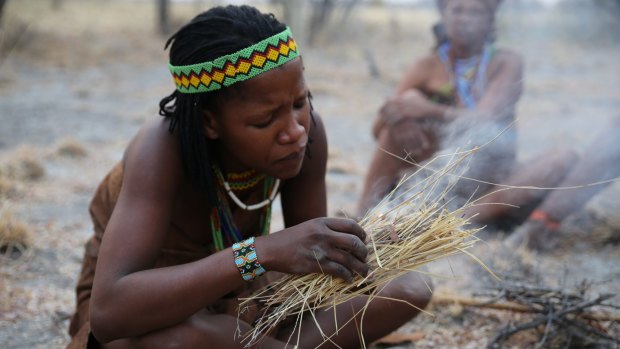
Learning how to make fire.Credit: Ben Groundwater
There is excitement in the air as the San bushman in front of me sits down in the grey dirt and starts digging. He's clutching a sharp stick in his hands, hammering it into the earth as everyone else crowds around, waiting for the prize that lies somewhere beneath.
It's not an easy dig. He hacks away at the soil for several minutes before finally uncovering the tuber, just the top of a brown blob that looks insignificant, but contains the gift of life.
Eventually it's lifted out of the earth, a prize held in gnarled hands. A small knife appears from out of a leather satchel, and the tuber is scraped, the flesh coming off in small chunks. One of the bushman takes the flesh in his hands, raises them above his head, points his thumbs towards his mouth, and squeezes.
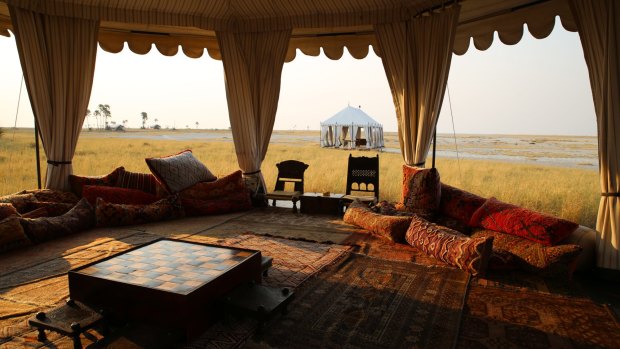
The luxurious San Camp in BotswanaCredit: Ben Groundwater
Water. Clear, cool water streams through his fingers and into his mouth. It seems like a miracle. Out here in the desert, miles from the nearest waterhole or stream, and we have found water. The gift of life.
Before we have had time to appreciate this miracle, however, the San guys have reburied the tuber and moved on. Next they're going to show us how to make fire. Then they'll show us a few traditional games. Then we'll learn how to track an animal.
This is a way of life that is slowly disappearing. The San people, sometimes known as the "bushmen", have lived in this desolate part of southern Africa, a harsh land that stretches through South Africa, Botswana, Namibia and Angola, for more than 45,000 years. These days, there are thought to be only about 90,000 San left, and only a few thousand still living the traditional hunting and gathering life, exercising their phenomenal ability to track animals and find water in the most unlikely places.
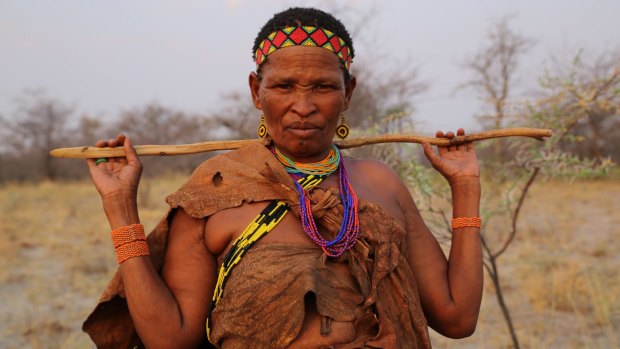
Traditional dress includes animal skins, with bright beads as jewellery.Credit: Ben Groundwater
One of the ways for the San to preserve their culture is to share it with foreign visitors, which is what's happening today. We're staying at a high-end safari lodge that is named in their honour – San Camp – so it makes sense that they would be given a chance to share what it is that makes the San unique.
The groups of San who live on this game reserve are rotated regularly, with new people coming in to teach their way of life as others go back into the desert to live it.
The sun is gradually dipping below the horizon now, bathing Botswana's Makgadikgadi salt pan in pale blue light. It's dusty here on the pan; a haze of sediment hangs permanently in the air, kicked up by the elephants and antelope, the lions and cheetahs that call this place home. It makes for spectacular sunsets as the huge orange orb dissolves into the haze.
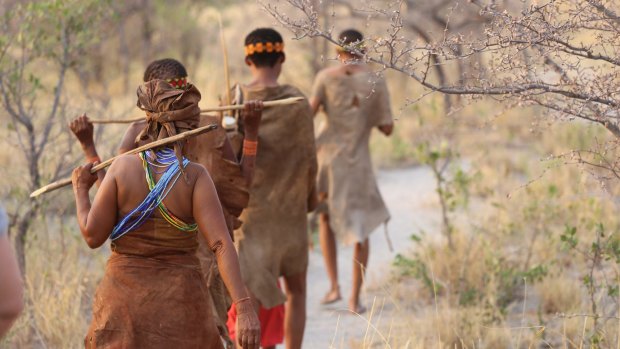
San people in Botswana.Credit: Ben Groundwater
For the San, the dipping of the sun means it's time to build a fire. One of the leaders of the group, who speaks to us through an interpreter, his language peppered with the clicks and rolls that the San are so famous for, has the gifts of a stage actor. He's bouncing around the clearing, pretending to be an antelope shot with an arrow, pretending to be a tuber being pulled out of the ground, gathering sticks for the fire, telling stories that even the interpreter is struggling to follow.
He is dressed traditionally in furs and animal skins, with bright beads as jewellery, but he is also covered in tattoos, markings that look almost Chinese. I ask about their significance and he just grins and says that he has no idea – he just thought they looked cool. He did them himself. Some things are universal.
This lesson in bush craft, however, is a rare brush with a people who are so often marginalised and ignored, not just in their countries of origin, but by the world at large. Remember the movie, The Gods Must Be Crazy? Those were San people they were making fun of. And it's still most foreigners' only point of reference to this ancient and sophisticated culture.
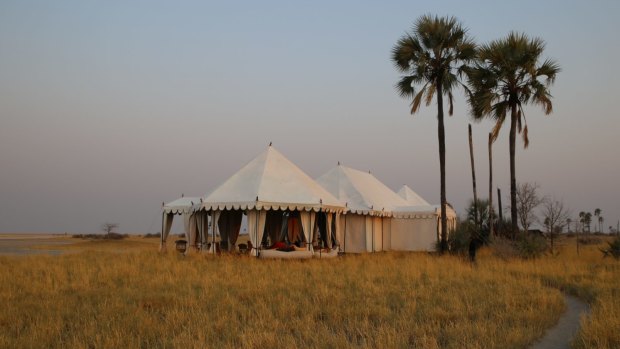
San Camp in Botswana.Credit: Ben Groundwater
The San can track an animal with phenomenal speed. They can tell you how old the hoof or paw prints are to the minute. They can tell you where the animal is going, and why. They can find water in dry, dusty earth. They can build fire with neither flint nor match. They can survive out on the Makgadikgadi.
While many people travel to Botswana for the wildlife, and to stay at incredible places like San Camp for the luxury and the relaxation, it's brushes like this with the indigenous culture that make you realise there is more to this land than photo opportunities and three-course meals. There is tradition. There is knowledge. And deep beneath the surface of the soil, there is life.
The writer stayed at San Camp as a guest of the Classic Safari Company
TRIP NOTES
MORE INFORMATION
GETTING THERE
Qantas flies direct from Sydney to Johannesburg, with connections to Maun in Botswana. See qantas.com. Charter flights are available from Maun to San Camp. See majorblueair.com
STAYING THERE
The Classic Safari Company offers three-night itineraries at San Camp, which include activities such as quad-biking on the salt pan, daily game drives, a meerkat experience and an evening with the San people, as well as all meals, drinks, guides and park entrance fees, for $5160 a person. See website above.
Sign up for the Traveller Deals newsletter
Get exclusive travel deals delivered straight to your inbox. Sign up now.